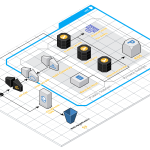Adopting DevOps can significantly enhance the efficiency and effectiveness of development and operations teams. However, organizations often encounter common challenges during the adoption process. Understanding and addressing these challenges is crucial for a successful DevOps implementation. This article explores key obstacles to DevOps adoption and provides strategies for overcoming them.
Common Challenges in DevOps Adoption
- Resistance to ChangeResistance to change is a significant barrier in DevOps adoption. Teams accustomed to traditional development and operations processes may be hesitant to embrace new practices and tools.
- Strategy to Overcome Resistance:
- Communicate the Benefits: Clearly articulate the benefits of DevOps, such as faster time-to-market, improved collaboration, and higher quality releases. Demonstrating how DevOps can address current pain points helps build support.
- Involve Stakeholders Early: Engage stakeholders early in the process to gain their buy-in. Involve them in planning and decision-making to ensure they feel invested in the change.
- Provide Training and Support: Offer training programs to help team members understand DevOps practices and tools. Provide ongoing support to address any concerns and facilitate a smooth transition.
- Strategy to Overcome Resistance:
- Lack of Skill and KnowledgeDevOps requires a diverse set of skills and knowledge, including expertise in automation, CI/CD, infrastructure management, and monitoring. A lack of these skills can hinder successful adoption.
- Strategy to Build Skills:
- Invest in Training: Provide training programs and resources to develop the necessary skills. Consider workshops, online courses, and certifications to enhance team members’ capabilities.
- Encourage Knowledge Sharing: Foster a culture of knowledge sharing within the organization. Encourage experienced team members to mentor others and share best practices.
- Hire or Contract Experts: If necessary, hire or contract experts with experience in DevOps to guide the adoption process and provide specialized knowledge.
- Strategy to Build Skills:
- Tool Overload and Integration IssuesThe DevOps ecosystem includes a wide range of tools for various functions such as CI/CD, monitoring, and infrastructure management. Managing tool integration and avoiding tool overload can be challenging.
- Strategy to Manage Tools:
- Select the Right Tools: Choose tools that align with your organization’s needs and integrate well with existing systems. Avoid adopting tools that do not address specific requirements or add unnecessary complexity.
- Prioritize Integration: Focus on integrating tools that streamline workflows and enhance collaboration. Use tools that offer compatibility and support for integrations with other systems.
- Evaluate and Simplify: Regularly evaluate the effectiveness of tools and simplify the toolchain where possible. Consolidate tools that offer overlapping functionalities to reduce complexity.
- Strategy to Manage Tools:
- Cultural and Organizational BarriersDevOps adoption often requires a cultural shift towards greater collaboration and shared responsibility between development and operations teams. Organizational silos and traditional hierarchies can impede this shift.
- Strategy to Address Cultural Barriers:
- Promote Collaboration: Foster a culture of collaboration by encouraging cross-functional teams and open communication. Implement practices that support joint planning, shared goals, and mutual respect between teams.
- Break Down Silos: Address organizational silos by aligning teams around common objectives and integrating workflows. Encourage interactions between development, operations, and other relevant departments.
- Implement Change Management: Use change management techniques to guide the cultural transition. Develop a change management plan that includes communication, training, and support to facilitate the shift to a DevOps culture.
- Strategy to Address Cultural Barriers:
- Managing Security and ComplianceSecurity and compliance considerations can pose challenges during DevOps adoption. Integrating security practices into DevOps processes while maintaining compliance with regulations is critical.
- Strategy to Address Security and Compliance:
- Integrate Security Practices: Implement security practices as part of the DevOps pipeline, known as DevSecOps. Incorporate automated security scanning, vulnerability assessments, and compliance checks into CI/CD processes.
- Develop Security Policies: Establish and enforce security policies that address access controls, data protection, and incident response. Ensure that policies are aligned with regulatory requirements and industry standards.
- Continuous Monitoring and Auditing: Implement continuous monitoring and auditing to detect and address security and compliance issues proactively. Use monitoring tools to track security metrics and conduct regular audits.
- Strategy to Address Security and Compliance:
- Scaling DevOps PracticesScaling DevOps practices to accommodate growing teams and projects can be challenging. Managing increased complexity, resource demands, and coordination issues requires careful planning.
- Strategy for Scaling:
- Implement Scalable Practices: Design DevOps practices and tools to scale with the organization. Use modular CI/CD pipelines, adopt Infrastructure as Code (IaC), and implement service orchestration for efficient scaling.
- Optimize Processes: Continuously review and optimize processes to handle scaling effectively. Streamline workflows, automate repetitive tasks, and improve efficiency to manage growth.
- Invest in Scalable Tools: Choose tools and platforms that support scaling and can handle increased demands. Use cloud-based solutions and scalable infrastructure to adapt to growth.
- Strategy for Scaling:
- Maintaining Consistency Across EnvironmentsEnsuring consistency across development, testing, and production environments is essential for reliable deployments. Inconsistent environments can lead to deployment issues and operational challenges.
- Strategy to Ensure Consistency:
- Use IaC for Environment Management: Implement Infrastructure as Code (IaC) to define and provision environments consistently. Ensure that environment configurations are reproducible and version-controlled.
- Adopt Configuration Management Tools: Use configuration management tools like Ansible or Puppet to manage and maintain consistent configurations across environments.
- Implement Automated Testing: Incorporate automated testing to validate environments and deployments. Use automated tests to ensure that changes work consistently across different environments.
- Strategy to Ensure Consistency:
Best Practices for Successful DevOps Adoption
- Start Small and Scale GraduallyBegin with a pilot project or a small-scale implementation to test DevOps practices. Use the insights gained from this initial phase to refine processes and scale adoption across the organization.
- Foster a Collaborative CultureEncourage collaboration and communication between development and operations teams. Promote a culture of shared responsibility and mutual support to facilitate successful DevOps adoption.
- Measure and OptimizeRegularly measure the effectiveness of DevOps practices using key performance indicators (KPIs). Use metrics to identify areas for improvement and optimize processes accordingly.
- Invest in Training and SupportProvide ongoing training and support to team members to ensure they have the skills and knowledge needed for successful DevOps adoption. Invest in resources that facilitate learning and development.
- Embrace Continuous ImprovementAdopt a mindset of continuous improvement by regularly reviewing and refining DevOps practices. Stay informed about emerging trends and technologies to keep practices up-to-date and effective.
Conclusion
Overcoming common challenges in DevOps adoption requires a strategic approach and a commitment to addressing obstacles effectively. By addressing resistance to change, building skills, managing tools, overcoming cultural barriers, and addressing security and compliance concerns, organizations can successfully implement DevOps practices. Scaling DevOps effectively, maintaining consistency, and following best practices contribute to successful adoption and ensure that DevOps delivers the intended benefits. Embracing these strategies helps organizations navigate the complexities of DevOps adoption and achieve enhanced efficiency, collaboration, and project success.
To learn more about our vision stay up to date with latest news and trends and how we’re making a difference, We invite you to OC-B by Oort X Media.




